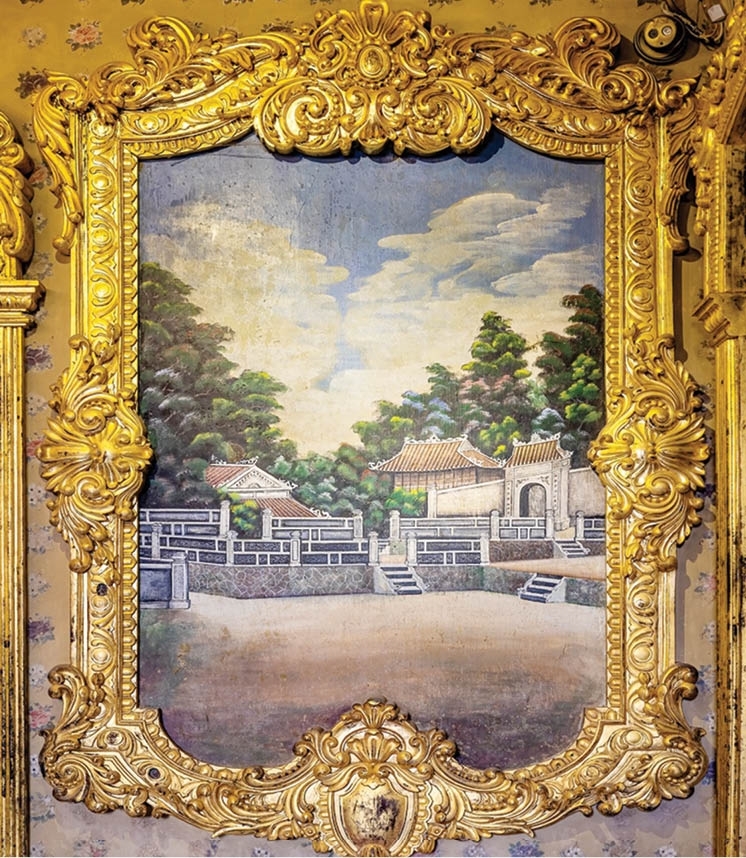    |
 |
| The sixth mural at An Dinh Palace |
There used to be many theories
An Dinh Palace was built during Emperor Khai Dinh’s reign in 1917, and is located on the bank of An Cuu River. In addition to the architecture which is considered a typical representative of the Vietnamese architectural style in the neo-classical period, the interior is also very elaborately decorated, especially the frescoes with high artistic value.
After many years of heavy damage, in 2002, Mr. Thomas Ulbrich, Vice Chairman of the Association for Cultural Exchange Leiniz - Germany and a volunteer working at the Hue Monuments Conservation Center, promoted the project of preserving and restoring six paintings located in the main hall of Khai Tuong mansion. After more than 5 years of conservation and restoration, these frescoes were restored according to the method of revert restoration, showing sharp and vivid appearance.
This set contains 6 paintings. Looking at the paintings, it is possible to realize the realistic perspective of the five emperors’ tombs: Gia Long, Minh Mang, Thieu Tri, Tu Duc, and Dong Khanh. As for the sixth painting, it is not clear which building is conveyed. Researchers have spent a lot of time trying to find the answer.
    |
 |
| The angle of the photo of Emperor Kien Phuc's mausoleum coincides with the landscape in the painting |
In the article "The mystery of ancient mural paintings in An Dinh palace" by Ngo Minh, a journalist, published on Tuoi Tre Weekend in 2003, Dr. Tran Duc Anh Son said that perhaps the painting was a painting of Khai Dinh's tomb while in the outline form on the drawing. That is the correct order of hierarchies, the order of emperors' tombs, because at the inauguration of An Dinh Palace, Emperor Khai Dinh was 33 years old and had just started designing the mausoleum...
The architect Phung Phu, former director of the Hue Monuments Conservation Centre, said that because An Dinh Palace was built by Emperor Khai Dinh when he first ascended the throne, he had not built a mausoleum at that time. So, it was not the landscape of Khai Dinh Tomb in the painting, but it could be a certain palace special to the court and the emperor himself.
The researcher Nguyen Dac Xuan also said that the sixth painting is the palace on the grounds of Emperor Dong Khanh’s tomb...
The answer from a young man
Nguyen Tan Anh Phong, a photography enthusiast who loves to photograph and study Nguyen Dynasty architecture from ancient documents, loves to explore unsolved mysteries. For many years now, Phong has spent time and effort looking for photos of ancient documents and then taking pictures of those monuments today, to compare the current status with the original documents.
Inspired by the past and present, Phong went to find the place depicted on the sixth painting at An Dinh palace. He did not agree with the above answers and went to find the solution himself.
Nguyen Tan Anh Phong recalled: “When taking picture of the sixth painting at An Dinh palace, people captioned it as the tomb of Emperor Dong Khanh. I was certain that in the six paintings, there cannot be two depicting the tomb of Emperor Dong Khanh. It must be another emperor's mausoleum. I researched from documentary photos and then took pictures to compare with the reality of many works, but none of them matched. The process took more than a year.”
During the visit and work of the Institute of the Far East at the Center for Conservation of Hue Monuments, they presented a number of documentary photos to the center, including Di Khiem Lau, a building belonging to the grounds of Khiem Tomb of Emperor Tu Duc which had collapsed. Boi Tomb (i.e., Emperor Kien Phuc's tomb) is also located in Khiem Tomb’s grounds and is next to Di Khiem Lau.
When taking pictures of Di Khiem Lau (now only the base) and Boi Tomb to compare with documentary photos, Phong discovered similarities between Boi Tomb and the sixth painting. The house on the left is Chiem Khiem Dien (the temple to worship Emperor Kien Phuc), the house in the middle is Di Khiem Lau. On the right is the gate to the tomb of Emperor Kien Phuc.
“Analyzing the recent digital photo documentary, I took the roof of Di Khiem Lau in the documentary photo and put it on the photo of the corner of Emperor Kien Phuc's mausoleum to see exactly every detail. I confirm that it is a painting of Emperor Kien Phuc's mausoleum. Moreover, according to my inference, even though there were 12 emperors during the reign of Emperor Khai Dinh, in the painting period, only the royal tombs were clearly identified as orthodox," said Phong.
Also, according to Anh Phong, researchers have questioned the sixth painting depicting Kien Phuc's mausoleum, but they were disoriented because Di Khiem Lau in the painting had collapsed.
It sounds simple, but to analyze this result is a feat with the applications of digital technology. Phong said: “When standing in Boi Tomb space, at a low angle, it is impossible to imagine the similarity between the painting and the actual context. But when I used a fly-cam to shoot, I could see the same details. The actual shooting angle assembled into the picture coincided completely.”
When he received the documents for appraisal, Dr. Tran Duc Anh Son also agreed with Phong's opinion about the 6th painting in An Dinh palace, which is a painting of the landscape of Emperor Kien Phuc's mausoleum. When certain, Nguyen Tan Anh Phong gave these scientific bases to Hue Museum of Royal Antiquities, the management unit of An Dinh palace. After analyzing and verifying, Hue Museum of Royal Antiquities changed the caption of the sixth picture to "Emperor Kien Phuc's Tomb".